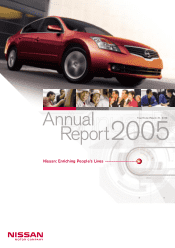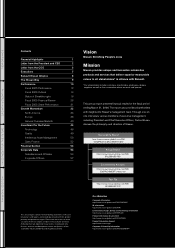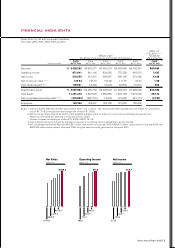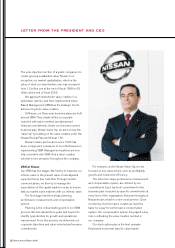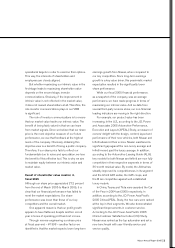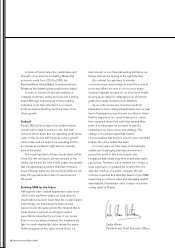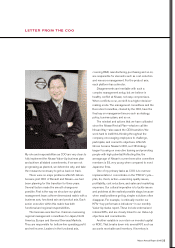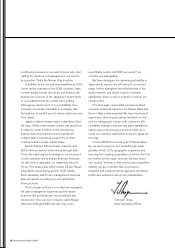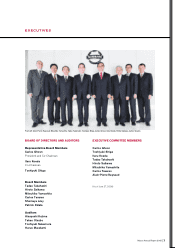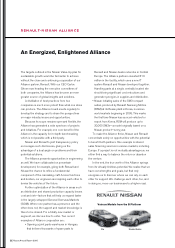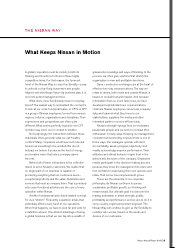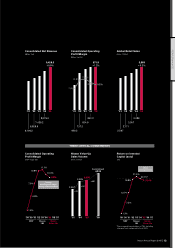Nissan 2006 Annual Report Download - page 5
Download and view the complete annual report
Please find page 5 of the 2006 Nissan annual report below. You can navigate through the pages in the report by either clicking on the pages listed below, or by using the keyword search tool below to find specific information within the annual report.
Nissan Annual Report 2005 3
operational targets in order to exercise their options.
This way, the interests of shareholders and
employees are closely aligned.
But whether maximizing our intrinsic value in the
first stage leads to maximizing shareholder value
depends on the second stage, investor
communications. Obviously, if the improvement in
intrinsic value is not reflected in the market value,
it does not reward shareholders at all. Therefore, the
role investor communications plays in our VBM
is significant.
The role of investor communications is to ensure
that our market value tracks our intrinsic value. The
benefit of being fairly valued is that we can learn
from market signals. Since we believe that our share
price is the most objective measure of our future
performance, we use that feedback at the highest
levels of the company. Obviously, obtaining this
objective view is a benefit of being a public company.
Therefore, if our share price fails to reflect our
fundamentals due to noise and speculation, we lose
the benefit of this effective tool. This is why we aim
to maintain equity between our intrinsic value and
market value.
Result of shareholder value creation in
fiscal 2005
Although our share price appreciated 27.2 percent
from the end of March 2005 to March 2006, it is
clear that our financial performance has failed to
meet the market expectations. Our share
performance was lower than those of our key
competitors and the overall market.
One apparent reason is that our profit growth
appears to have flattened, despite another record
year in terms of operating profit and net income.
Through reverse-engineering our share price
at fiscal year-end – ¥1398 – another factor we
identified is that the market expects lower long-term
earnings growth from Nissan, when compared to
our key competitors. Since long-term earnings
growth is a key value driver, this pessimistic market
expectation resulted in the significantly lower
share performance.
While our fiscal 2005 financial performance,
as a snapshot of the company, was an average
performance, we have made progress in terms of
maximizing our intrinsic value. And as data from
several third-party sources show, our non-financial
leading indicators are moving in the right direction.
For example, our product value has been
increasing. In the U.S., according to the J.D. Power
and Associates 2005 Automotive Performance,
Execution and Layout (APEAL) Study, a measure of
owners’ delight with the design, content, layout and
performance of their new vehicles, both Nissan and
Infiniti advanced their scores. Nissan maintained a
significant gap against the non-luxury average and
Infiniti moved past the luxury average. In addition,
according to the Automotive Leasing Guide (ALG),
key models for both Nissan and Infiniti are now fully
competitive in their respective segments in terms of
36-month residual value. By model, the Altima has
steadily improved its competitiveness in its segment
and the Infiniti G35 sedan, the G35 coupe, and
the M are competitive against well-established
luxury models.
In China, Teana and Tiida were awarded the Car
of the Year in 2004 and 2005 respectively. In
addition, according to the J.D. Power Asia Pacific
2005 China APEAL Study, the two cars were ranked
at the top in their segments. We also demonstrated
significant improvements in customer service.
According to the J.D. Power Asia Pacific 2005
China Customer Satisfaction Index (CSI) Study,
Nissan was ranked as the top automaker and set a
new benchmark with user-friendly service and
service quality.

